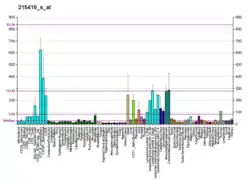STOML2
Stomatin-like protein 2 is a protein that in humans is encoded by the STOML2 gene.[4][5][6]
References
- GRCh38: Ensembl release 89: ENSG00000165283 - Ensembl, May 2017
- "Human PubMed Reference:". National Center for Biotechnology Information, U.S. National Library of Medicine.
- "Mouse PubMed Reference:". National Center for Biotechnology Information, U.S. National Library of Medicine.
- Wang Y, Morrow JS (Apr 2000). "Identification and characterization of human SLP-2, a novel homologue of stomatin (band 7.2b) present in erythrocytes and other tissues". J Biol Chem. 275 (11): 8062–71. doi:10.1074/jbc.275.11.8062. PMID 10713127.
- Hajek P, Chomyn A, Attardi G (Feb 2007). "Identification of a novel mitochondrial complex containing mitofusin 2 and stomatin-like protein 2" (PDF). J Biol Chem. 282 (8): 5670–81. doi:10.1074/jbc.M608168200. PMID 17121834. S2CID 2167533.
- "Entrez Gene: STOML2 stomatin (EPB72)-like 2".
Further reading
- Maruyama K, Sugano S (1994). "Oligo-capping: a simple method to replace the cap structure of eukaryotic mRNAs with oligoribonucleotides". Gene. 138 (1–2): 171–4. doi:10.1016/0378-1119(94)90802-8. PMID 8125298.
- Suzuki Y, Yoshitomo-Nakagawa K, Maruyama K, et al. (1997). "Construction and characterization of a full length-enriched and a 5'-end-enriched cDNA library". Gene. 200 (1–2): 149–56. doi:10.1016/S0378-1119(97)00411-3. PMID 9373149.
- Zhang QH, Ye M, Wu XY, et al. (2001). "Cloning and functional analysis of cDNAs with open reading frames for 300 previously undefined genes expressed in CD34+ hematopoietic stem/progenitor cells". Genome Res. 10 (10): 1546–60. doi:10.1101/gr.140200. PMC 310934. PMID 11042152.
- Owczarek CM, Treutlein HR, Portbury KJ, et al. (2001). "A novel member of the STOMATIN/EPB72/mec-2 family, stomatin-like 2 (STOML2), is ubiquitously expressed and localizes to HSA chromosome 9p13.1". Cytogenet. Cell Genet. 92 (3–4): 196–203. doi:10.1159/000056902. PMID 11435687. S2CID 19349691.
- Strausberg RL, Feingold EA, Grouse LH, et al. (2003). "Generation and initial analysis of more than 15,000 full-length human and mouse cDNA sequences". Proc. Natl. Acad. Sci. U.S.A. 99 (26): 16899–903. doi:10.1073/pnas.242603899. PMC 139241. PMID 12477932.
- Ota T, Suzuki Y, Nishikawa T, et al. (2004). "Complete sequencing and characterization of 21,243 full-length human cDNAs". Nat. Genet. 36 (1): 40–5. doi:10.1038/ng1285. PMID 14702039.
- Humphray SJ, Oliver K, Hunt AR, et al. (2004). "DNA sequence and analysis of human chromosome 9". Nature. 429 (6990): 369–74. doi:10.1038/nature02465. PMC 2734081. PMID 15164053.
- Gerhard DS, Wagner L, Feingold EA, et al. (2004). "The status, quality, and expansion of the NIH full-length cDNA project: the Mammalian Gene Collection (MGC)". Genome Res. 14 (10B): 2121–7. doi:10.1101/gr.2596504. PMC 528928. PMID 15489334.
- Rush J, Moritz A, Lee KA, et al. (2005). "Immunoaffinity profiling of tyrosine phosphorylation in cancer cells". Nat. Biotechnol. 23 (1): 94–101. doi:10.1038/nbt1046. PMID 15592455. S2CID 7200157.
- Guo D, Han J, Adam BL, et al. (2005). "Proteomic analysis of SUMO4 substrates in HEK293 cells under serum starvation-induced stress". Biochem. Biophys. Res. Commun. 337 (4): 1308–18. doi:10.1016/j.bbrc.2005.09.191. PMID 16236267.
- Zhang L, Ding F, Cao W, et al. (2006). "Stomatin-like protein 2 is overexpressed in cancer and involved in regulating cell growth and cell adhesion in human esophageal squamous cell carcinoma". Clin. Cancer Res. 12 (5): 1639–46. doi:10.1158/1078-0432.CCR-05-1858. PMID 16533792.
- John JP, Anrather D, Pollak A, Lubec G (2006). "Mass spectrometrical verification of stomatin-like protein 2 (SLP-2) primary structure". Proteins. 64 (2): 543–51. doi:10.1002/prot.20987. PMID 16671055. S2CID 24782924.
- Cui Z, Zhang L, Hua Z, et al. (2007). "Stomatin-like protein 2 is overexpressed and related to cell growth in human endometrial adenocarcinoma". Oncol. Rep. 17 (4): 829–33. doi:10.3892/or.17.4.829. PMID 17342323.
- Cao W, Zhang B, Liu Y, et al. (2007). "High-level SLP-2 expression and HER-2/neu protein expression are associated with decreased breast cancer patient survival". Am. J. Clin. Pathol. 128 (3): 430–6. doi:10.1309/C6X54HRB580EP2NQ. PMID 17709317.
This article is issued from Wikipedia. The text is licensed under Creative Commons - Attribution - Sharealike. Additional terms may apply for the media files.


